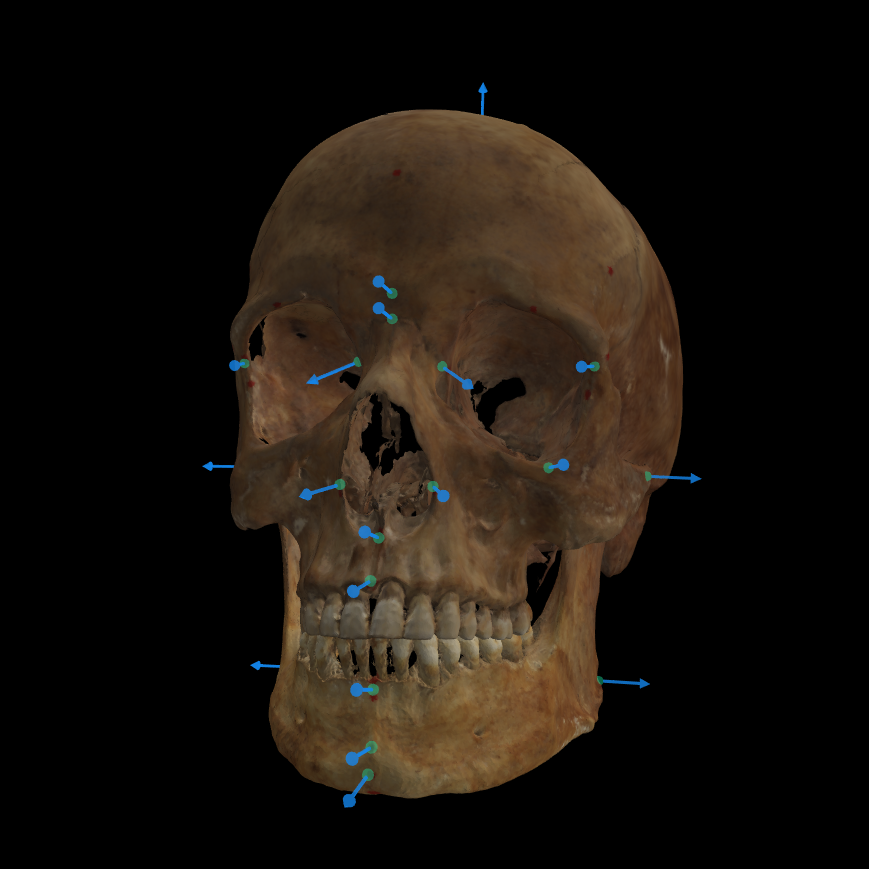
Craniofacial Superimposition Extended Course
With this training you will understand (in addition to all the contents of the course ‘Fundamentals of Craniofacial Superimposition’) the anatomy of the craniofacial complex and the relationships between the skull and the face. You will learn the criteria used by experts to study these relationships and you will analyse correspondences on real cases with the Skeleton-ID software. You will solve cases of craniofacial superimposition from start to finish, making decisions and familiarising yourself with expert reports. Finally, you will understand the latest advances in standardisation and validation of the technique and the challenges that lie ahead.
| Hours of published material | 1 day 15 hours 4 minutes |
|---|
Share This Course
Share Link
Share on Social Media
Share by Email
Please login to share this Craniofacial Superimposition Extended Course by email.
-
SESSION 1 - INTRODUCTION TO THE TECHNIQUE
-
1.1 Introduction to Craniofacial Superimposition
-
1.2 Methodological framework and good practices
-
1.3 Good practice in the procurement of AM/PM materials
-
1.5 Introduction to Skeleton-ID
-
Exercise 1: Creation of a dossier
-
S1. Further reading and resources10 xp
-
-
SESSION 2 - MARKING OF LANDMARKS
-
2.1 Cephalometric landmarks
-
2.1.2 Skeleton-ID: 2D Scene
-
2.2 Craniometric landmarks
-
2.2.2 Skeleton-ID: 3D Scene
-
2.3 Soft tissue
-
2.3.2 Skeleton-ID: Tissue Vectors
-
Exercise 2: Marking anthropometric landmarks
-
S2. Further reading and resources10 xp
-
-
SESSION 3 - OVERLAPPING SCENE / JAW ARTICULATION
-
3.1 Craniofacial overlap as a calibration problem
-
3.1.2 Skeleton-ID: Skull-Face Overlap Scene
-
Exercise 3: Fundamentals of 2D-3D superimposition
-
Exercise 4: Skull-Face Overlap
-
3.2 Temporomandibular joint
-
3.2.2 Skeleton-ID: Jaw Joint
-
Exercise 5: Jaw articulation
-
S3. Further reading and resources10 xp
-
-
SESSION 4 - EVALUATION IN SCF
-
4.1 Anatomical relationships of the craniofacial complex
-
4.2 Assessment of anatomical correspondences
-
4.2.2 Skeleton-ID: Anatomical matching assessment
-
Exercise 6: Evaluation of the ‘Laskowski Case’.
-
S4. Further reading and resources10 xp
-
-
Session 5 - DECISION MAKING
-
5.1 Decision-making
-
5.1.2 Skeleton-ID: Report generation
-
Exercise 7: Case study ‘Gediminas Castle’.
-
S5. Further reading and resources10 xp
-
-
SESSION 6 - VALIDATION STUDIES AND FUTURE OF THE TECHNIQUE
-
6.1 Validation studies
-
6.2 Use cases
-
6.3 Future of the technique
-
Exercise 8: Case study ‘Pico Mulhacén’.
-

Learn at your own pace
Once you register for the course, you choose the pace at which you want to learn. You can access the content whenever you want, wherever you want. You have up to half a year to complete each course from the time you enrol.

For all types of professionals
Our courses are aimed at any professional with an interest in the fields of anthropology, medicine, research, biology, etc.

Face-to-face sessions
Through an arranged video-tutorial, you will receive personalised attention from our experts to resolve any doubts or questions about the topics covered during the course.

Certified courses
All courses have official certificates upon completion of the course that will allow you to complement your CV and expand your professional network by sharing it, for example, on Linkedin.

Book your video tutorial
Contact us to book your personal tutoring with one of our experts and you will be able to solve all your doubts.
Our experts
Discover our comprehensive software
Skeleton-ID forensic identification software is used by law enforcement and government agencies around the world whenever DNA and fingerprints are not an option.

Frequently asked questions
Our course is aimed at any professional who has knowledge of anatomy and is interested in the field of anthropology, medicine, forensic sciences, biology, etc.
- Mouse
- Up-to-date Google Chrome
- 4-core processor
- 8GB of RAM (16GB recommended)
*If the minimum requirements are not met, it is still possible to participate, but we cannot guarantee a smooth user experience.
All courses are conducted through Panacea's eLearning platform.
Once you request access to the course you will receive an email with a link to access the payment. Once we confirm that your payment has been successfully completed through this link, we will confirm your access to the course and you will be able to start immediately.
You can start the course after paying the registration fee.
From the moment you register for the course, you will have 6 months to complete the course. Once this period of time has expired, you will lose access to both the content published on the Panacea platform and the Skeleton-ID software that you will use to carry out the practical exercises.
Currently the course is only available in Spanish. In the future all the courses will also be in English, follow us to keep up to date with all the news.
The course is divided into 6 blocks. Each block contains a theoretical part taught by our experts, practical exercises to consolidate what has been learnt and additional readings or resources to complement the content.
Yes, upon completion of the course you will receive your official certificate of completion.
Get in touch with our experts.
Yes, at any time, but you will not get a refund.
If you have any questions or problems, you can contact us at support+forensic@panacea-coop.com.
Legal Terms and Conditions
Although this site may be linked to other sites, this does not imply, either directly or indirectly, any approval, association, sponsorship, endorsement or affiliation by us with such sites unless specifically stated herein.
You should carefully review the legal and other terms of use of websites to which you link from this Website. Your linking to other external websites or portals is at your own risk.
The Website may use cookies to personalise and facilitate the User's full browsing of the Website. Users can configure their browser to notify and reject the installation of cookies sent by us.



